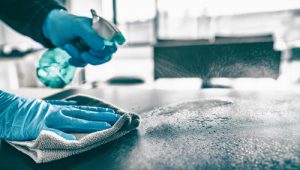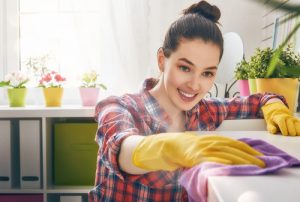
Keeping your home in mint condition requires a number of procedures. Two of the most important ones are cleaning and disinfection. Now that the coronavirus can easily find its way into your home, knowing the intricacies of both processes is a must.
If you’re not sure just why cleaning and disinfecting are not the same, no worries. Your go-to Thornton cleaning services are here to clear up any confusion. All you need to know to get a pristine and healthy house is right here. Stay tuned.
Is cleaning the same as disinfecting?
Contrary to popular belief, cleaning and disinfecting are not the same. They are performed using different substances, through different methods, and achieve different goals.
Cleaning and disinfecting are indeed distinct processes with different objectives and methods. Understanding the difference between the two is crucial for maintaining a clean and healthy environment.
Cleaning primarily focuses on removing dirt, dust, debris, and visible stains from surfaces. It involves the use of cleaning agents, such as soap, detergents, or other specialized cleaners, along with mechanical actions like scrubbing, wiping, or rinsing. The purpose of cleaning is to eliminate dirt and grime, improving the appearance and hygiene of the surfaces.
Disinfecting, on the other hand, is aimed at killing or inactivating germs, bacteria, viruses, and other microorganisms on surfaces. It involves using disinfectants that are specifically designed to destroy or neutralize these harmful pathogens. Disinfectants are typically more potent than regular cleaning agents and may require specific contact time to effectively eliminate the microorganisms.
While cleaning and disinfecting are distinct processes, they often go hand in hand to ensure thorough cleanliness and hygiene. In many situations, it is recommended to clean surfaces first to remove any visible dirt or contaminants before applying a disinfectant.
It’s important to note that not all cleaning agents have disinfecting properties, and vice versa. Therefore, if your goal is to kill germs and prevent the spread of infectious diseases, it’s necessary to use appropriate disinfectants as recommended by health authorities.
Regular cleaning, along with proper disinfection when needed, can help maintain a clean and safe environment by reducing the risk of infections and promoting overall hygiene. It’s important to follow guidelines and best practices for cleaning and disinfection to ensure effective results and protect the health of yourself and others.
Cleaning
On the one hand, cleaning has to do with removing dirt and germs from a surface, as well as organizing a space. However, you cannot kill any germs when you clean. All you can do is reduce their number on a particular surface. Still, this does reduce the risk of infection, which is invaluable at the moment.
Cleaning plays a crucial role in reducing the presence of dirt, germs, and contaminants on surfaces, which in turn helps minimize the risk of infection. While cleaning may not eliminate all germs, it is an essential step in maintaining a clean and hygienic environment.
By removing dirt, debris, and visible contaminants through cleaning practices such as dusting, sweeping, mopping, or wiping surfaces, you can significantly reduce the number of germs present. This is important because many pathogens can survive on surfaces for varying periods of time and may be transmitted through contact.
Regular cleaning is particularly valuable during times when infectious diseases are a concern. It can help remove pathogens from frequently touched surfaces, such as doorknobs, countertops, light switches, and other high-contact areas, thereby reducing the likelihood of transmission.
While cleaning alone may not completely eliminate all germs, it is an integral part of a comprehensive approach to maintaining a clean and safe environment. Combining cleaning with proper disinfection practices, when necessary, further enhances the effectiveness of reducing the risk of infection.
It’s important to note that following recommended cleaning protocols, using appropriate cleaning agents, and practicing good hygiene, such as handwashing, are all important measures in reducing the spread of germs and maintaining a healthy living or working space.
In summary, cleaning may not kill all germs, but it is a vital step in reducing their presence on surfaces and minimizing the risk of infection. Regular cleaning, along with proper disinfection and hygiene practices, is a valuable strategy for promoting a clean and safe environment for everyone.
Disinfecting
On the other hand, the sole purpose of disinfection is to eliminate viruses and other pathogens. It won’t necessarily help make your home shinier, but it will turn it into a much healthier place.
Disinfection serves a distinct purpose from cleaning. While cleaning focuses on removing dirt and visible contaminants, disinfection specifically targets and eliminates viruses, bacteria, and other pathogens that may be present on surfaces.
The primary goal of disinfection is to reduce the risk of spreading infectious diseases by destroying or inactivating harmful microorganisms. Disinfectants are designed to be effective against specific types of pathogens and are formulated to ensure maximum efficacy.
Disinfection is particularly important in high-touch areas or surfaces that are frequently exposed to germs, such as doorknobs, light switches, countertops, bathroom fixtures, and shared items. These surfaces can act as breeding grounds for bacteria and viruses, making regular disinfection essential for maintaining a healthier environment.
It’s important to note that disinfection should be performed in addition to regular cleaning, as cleaning alone may not be sufficient to eliminate pathogens. By combining both cleaning and disinfection practices, you can achieve a thorough approach to reducing the spread of infectious diseases and promoting a healthier living space.
While disinfection may not visibly improve the shine or appearance of your home, its primary focus is on creating a healthier environment by reducing the presence of harmful pathogens. By implementing proper disinfection practices, you can help protect yourself, your family, and others from potential infections.
Remember to follow guidelines and recommendations from health authorities when selecting and using disinfectants to ensure their proper and safe application. Regular cleaning and disinfection, along with other hygiene practices like handwashing, are essential in maintaining a healthy and safe living space.
What is the difference between cleaning and disinfecting?
Again, what sets cleaning apart from disinfecting is that it can’t kill viral particles. It simply lowers their presence in a certain area. To be absolutely sure that there are no infectious microbes in your home, you just can’t do without disinfection.
While cleaning helps remove dirt and reduce the number of germs on surfaces, it does not have the ability to kill viral particles or provide complete assurance of eliminating infectious microbes. Disinfection, on the other hand, is specifically designed to destroy or inactivate viruses, bacteria, and other pathogens, providing an additional level of assurance when it comes to creating a safer and healthier environment.
Viruses, including viral particles such as those responsible for infectious diseases, require specific measures to be effectively neutralized. Disinfectants are formulated with ingredients that have been proven to target and eliminate a wide range of pathogens, including viruses.
During times when infectious diseases are a concern, such as the current COVID-19 pandemic, incorporating proper disinfection practices is highly recommended to help reduce the risk of transmission. Disinfecting commonly touched surfaces and objects, such as doorknobs, light switches, countertops, and electronic devices, can help inactivate any viral particles that may be present.
It’s important to note that cleaning and disinfection should go hand in hand to achieve the most effective results. By first cleaning surfaces to remove dirt and debris, followed by appropriate disinfection protocols, you can create a more hygienic and safer environment.
While cleaning plays an important role in overall cleanliness and reducing the presence of germs, disinfection is crucial for targeting and eliminating specific pathogens, including viral particles. Combining both cleaning and disinfection practices is a comprehensive approach to maintaining a healthier home and minimizing the risk of infectious diseases.
It’s always advisable to follow guidelines and recommendations from health authorities and use approved disinfectants to ensure proper and effective disinfection.
It’s also important to note that cleaning incorporates a large number of procedures. Some of the most common ones are:
- Dusting
- Scrubbing
- Sweeping
- Vacuuming
- Mopping
You clean whenever you want to deal with stains, grease, or debris. In other words, cleaning enables you to tackle all the impurities visible to the naked eye.
Conversely, disinfection is the answer to the invisible threat – vicious microorganisms all around the house. To disinfect properly, you can use bleach solutions, alcohol solutions with 70% alcohol, or an EPA-approved disinfectant. Whatever you opt for, don’t forget to wear disposable gloves while disinfecting, and make sure to wash your hands afterward.
Why should you clean before disinfecting?
Whenever you’re planning to disinfect a surface, you should always clean it beforehand. The reason for this is simple: germs can hide beneath dirt and debris, which makes it difficult for disinfectants to detect them. In addition, dirt and organic material make disinfectants less potent. This means that germs can still remain on a surface even after you’re done disinfecting.
So, disinfection is at its best when it’s a two-step process. For instance, if you’re looking to protect your kitchen from COVID-19, first clean the countertops and other surfaces, and then move on to disinfecting or sanitizing.
Cleaning surfaces before disinfection is an essential step to ensure the effectiveness of the disinfection process. Cleaning helps remove dirt, dust, and organic matter from the surfaces, which may harbor germs and create a barrier that hinders the disinfectant’s ability to reach and kill pathogens.
By removing the visible dirt and debris through cleaning, you are not only improving the appearance of the surface but also enhancing the efficacy of the disinfectant. When the surface is clean, the disinfectant can come into direct contact with the pathogens, increasing its ability to kill them effectively.
It’s important to note that disinfectants work best on pre-cleaned surfaces. Without proper cleaning, the presence of dirt and organic material can interfere with the disinfectant’s ability to penetrate and kill germs, potentially leaving behind pathogens that may pose a risk.
To create a thorough and effective disinfection process, it is recommended to follow a two-step approach: cleaning followed by disinfection. Start by cleaning the surfaces using appropriate cleaning agents or detergents to remove visible dirt, grease, or grime. Once the surface is clean, you can proceed with applying a suitable disinfectant according to the manufacturer’s instructions to kill any remaining germs.
This two-step process helps ensure that both cleaning and disinfection are performed effectively, providing a safer and more hygienic environment. Whether it’s protecting against COVID-19 or other infectious diseases, incorporating proper cleaning and disinfection practices is crucial for maintaining a clean and healthy living space.
Book quality Thornton cleaning services and your home will get a fresh look

Wouldn’t you like to make housework a thing of the past? With Blue Spruce Maids, you can do just that with just a few clicks! Just hire our dependable cleaning experts who will make your home sparkle like never before.
We are here to answer all your cleaning calls. Whether you need regular-visit or initial-visit clean-ups, Blue Spruce Maids are available at all times. On top of that, look no further for a thorough move-in/move-out cleaning. We guarantee absolute satisfaction with all our services.
How many times have chores prevented you from going out and having a blast? With us by your side, that will no longer be the case. Take your family out for some thrills at Elitch Gardens Theme Park and leave the cleaning to the best in the biz.
Book Blue Spruce Maids now!